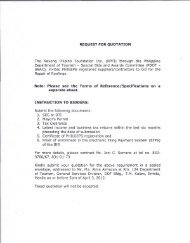regulatory impact assessment (ria) guidelines - It's More Fun in the ...
regulatory impact assessment (ria) guidelines - It's More Fun in the ...
regulatory impact assessment (ria) guidelines - It's More Fun in the ...
You also want an ePaper? Increase the reach of your titles
YUMPU automatically turns print PDFs into web optimized ePapers that Google loves.
PHILIPPINES - REGULATORY IMPACT ASSESSMENT (RIA) GUIDELINES<br />
DRAFT – FOR DISCUSSION AND FINALISATION<br />
1. PURPOSE AND OBJECTIVES<br />
The Regulatory Impact Assessment (RIA) Guidel<strong>in</strong>es assist <strong>the</strong> Department of F<strong>in</strong>ance (DOF), Department of Labour and Employment (DOLE)<br />
and Department of Tourism (DOT) staff responsible for develop<strong>in</strong>g, review<strong>in</strong>g and improv<strong>in</strong>g regulation to produce better regulation <strong>in</strong><br />
accordance with <strong>regulatory</strong> best practice pr<strong>in</strong>ciples.<br />
RIA is a process that is part of <strong>the</strong> broader regulation mak<strong>in</strong>g and review processes of <strong>the</strong> departments. The RIA process promotes <strong>assessment</strong><br />
of <strong>the</strong> <strong>impact</strong>s of a regulation with proper methodology, <strong>in</strong>clud<strong>in</strong>g cost-benefit analysis and stakeholder consultation to ensure that <strong>the</strong> regulation<br />
is effective and efficient <strong>in</strong> achiev<strong>in</strong>g policy objectives while m<strong>in</strong>imis<strong>in</strong>g negative effects on stakeholders affected.<br />
See attachment A for Philipp<strong>in</strong>es RIA Quick Reference Guide for overview of <strong>the</strong> RIA system be<strong>in</strong>g piloted at DOF, DOLE and DOT.<br />
2. CONTEXT FOR RIA ADOPTION<br />
2.1 Reasons for RIA Regime <strong>in</strong> Philipp<strong>in</strong>es<br />
Good regulation is fundamental to a well function<strong>in</strong>g economy and society. It protects <strong>the</strong> community, bus<strong>in</strong>ess and <strong>the</strong> environment.<br />
Conversely, regulation that is unnecessary or poorly designed can impose significant cost on bus<strong>in</strong>ess, community and government through<br />
<strong>in</strong>efficiencies due to <strong>the</strong> time taken to understand, comply with and enforce <strong>the</strong>se regulations. This has <strong>the</strong> perverse result of lower efficiency<br />
and profits for bus<strong>in</strong>ess, higher prices for consumers, and greater adm<strong>in</strong>istration costs for government.<br />
The 2012 World Bank’s Do<strong>in</strong>g Bus<strong>in</strong>ess report ranks <strong>the</strong> Philipp<strong>in</strong>es 136 out of 182 countries <strong>in</strong> terms of <strong>the</strong> ease of do<strong>in</strong>g bus<strong>in</strong>ess, a drop of 2<br />
places from a rank<strong>in</strong>g of 134 <strong>in</strong> 2011. In 7 out of 10 topics, <strong>the</strong> Philipp<strong>in</strong>es’ rank<strong>in</strong>gs dropped up to 10 places compared with performance <strong>in</strong><br />
2011. The report provides some comparative examples of <strong>the</strong> difficulties with do<strong>in</strong>g bus<strong>in</strong>ess <strong>in</strong> <strong>the</strong> Philipp<strong>in</strong>es. For example, <strong>the</strong> World Bank<br />
estimates 15 procedures are required to start a bus<strong>in</strong>ess <strong>in</strong> <strong>the</strong> Philipp<strong>in</strong>es (compared with 5 procedures <strong>in</strong> OECD countries), tak<strong>in</strong>g an estimated<br />
35 days (compared with 12 days <strong>in</strong> OECD countries). The cost of start<strong>in</strong>g a bus<strong>in</strong>ess (as a % of <strong>the</strong> economy’s <strong>in</strong>come per capita) is also very<br />
high (19.1% <strong>in</strong> <strong>the</strong> Philipp<strong>in</strong>es compared with 4.7% <strong>in</strong> OECD countries). As <strong>the</strong> Micro, Small and Medium Enterprises sector (MSMEs)<br />
accounts for over 99% of enterprises <strong>in</strong> <strong>the</strong> Philipp<strong>in</strong>es, <strong>the</strong> burden of <strong>the</strong>se costs falls disproportionately on MSMEs.<br />
Version 4.0 23 July 2012 DRAFT Page 4/24
















